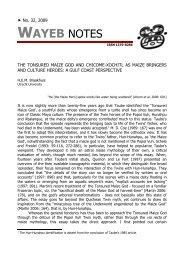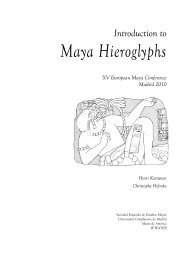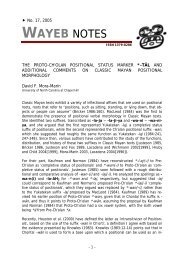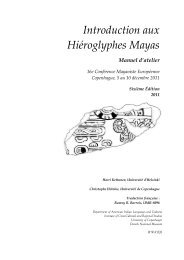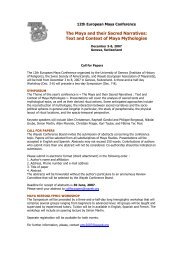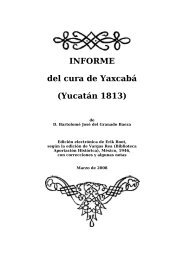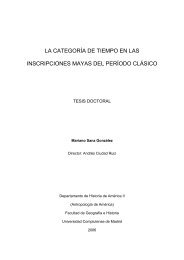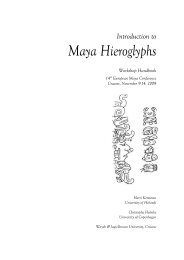Introduction to Maya Hieroglyphs - Wayeb
Introduction to Maya Hieroglyphs - Wayeb
Introduction to Maya Hieroglyphs - Wayeb
You also want an ePaper? Increase the reach of your titles
YUMPU automatically turns print PDFs into web optimized ePapers that Google loves.
Kettunen & Helmke 2011<br />
Appendices<br />
TRANSITIVE VERBS: (CVC)<br />
(1) ACTIVE: ERG-CVC-V1w-ABS<br />
In the active voice, the agent is the subject of the verb, whereas the patient is the object of the verb.<br />
u-chu-ku-wa<br />
uchukuw<br />
u-chuk-uw-Ø<br />
“he/she seized…”<br />
Example:<br />
uchukuw Aj Ukul? Yaxuun Bahlam<br />
“Yaxuun Bahlam seized Aj Ukul”<br />
In the active voice of transitive verbs the root is preceded by the third-person pronoun u- (“he/she/it”), and<br />
followed by the syllabic sign wa which points <strong>to</strong> the -Vw thematic suffix for active transitive constructions. The -<br />
Vw represents a vowel resonating the vowel of the verbal root; examples: u-chok-ow (“he/she threw it”); u-tz’apaw<br />
(“he/she inserted/planted it”); and u-but’-uw (“he/she buried it”). However, in the <strong>Maya</strong> script the graphemic<br />
suffix of transitive verbs in active voice is constantly marked with a wa syllabogram regardless of the vowel of<br />
the verbal root 68 .<br />
(2) PASSIVE: CVhC-aj-ABS 69<br />
In the passive voice, the patient becomes the subject of the verb and the agent is either completely removed or<br />
hidden in an oblique (indirect) phrase/clause.<br />
tzu-tza-ja tz’a-pa-ja chu-ka-ja<br />
tzu[h]tzaj tz’a[h]paj chu[h]kaj<br />
tzu[h]tz-aj-Ø tz’a[h]p-aj-Ø chu[h]k-aj-Ø<br />
“(it) was finished” “(it) was planted” “(he/she/it) was seized”<br />
Example:<br />
chuhkaj Aj Ukul? (ukabjiiy Yaxuun? Bahlam)<br />
“Aj Ukul? was seized (by the doing of Yaxuun? Bahlam)”<br />
68<br />
It seems reasonable <strong>to</strong> argue that the thematic suffix for active transitive constructions is –Vw rather than –V’w, although Lacadena and<br />
Wichmann (2005: 32) state that “[t]he glottal is not straightforwardly reconstructible, but we do note that Chontal has a glottal in its corresponding<br />
morpheme –e’. This suffix could have developed from –V1’w by a replacement of the harmonic vowel with e and by a loss of the w. Even if a glottal<br />
s<strong>to</strong>p in the thematic suffix is not reconstructed for pro<strong>to</strong>-<strong>Maya</strong>n there is still a possibility that it could have been present in pro<strong>to</strong>-Ch’olan as an<br />
innovation in this group.” In the current volume the thematic suffix for active transitive constructions is marked as –Vw and thus contradicting<br />
the harmony rules by Lacadena and Wichmann (see Appendix J). It should be noted here that these harmony rules do not seem <strong>to</strong> apply<br />
uniformly <strong>to</strong> all verbal cases, along with several other parts of speech. Ancient scribes were – and modern epigraphers are – faced with a challenge<br />
in the absence of the wu syllabogram which is needed if a word ending in –uw is <strong>to</strong> be rendered (based on harmony rules by Lacadena and<br />
Wichmann). Consequently, these harmony rules are far from being seamless. It appears as if the <strong>Maya</strong> scribes only employed a limited set of final<br />
syllabograms without specifically indicating complexity in the root vowel (or any preceding vowel). Statistically, these final syllabograms tend <strong>to</strong><br />
take primarily /a/, /i/, or /e/ vowels (–Va, –Vi , and –Ve), and particularly the first two, with /o/ and /u/ (–Vo and –Vu), being infrequent.<br />
Consequently, it seems that disharmonic spelling by itself does not necessarily denote vowel complexity, and nor does synharmonic spelling<br />
always indicate short vowels. The <strong>Maya</strong> writing system in general is not a sterile and mechanical apparatus (no more than any other writing<br />
system in the world) and it should not be forced <strong>to</strong> fit a fixed pattern of linguistic theory (Kettunen 2009, 2010).<br />
69<br />
Note that the (reconstructed) infixed -h- is the true passivizer, and the -aj suffix is solely thematic and derivational (detransitivizer).<br />
67/154



